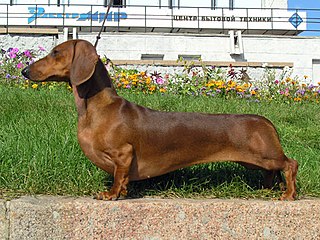
The dachshund, also known as the wiener dog or sausage dog, badger dog and doxie, is a short-legged, long-bodied, hound-type dog breed. The dog may be smooth-haired, wire-haired, or long-haired. Coloration varies.

The Labrador Retriever or simply Labrador is a British breed of retriever gun dog. It was developed in the United Kingdom from St. John's water dogs imported from the colony of Newfoundland, and was named after the Labrador region of that colony. It is among the most commonly kept dogs in several countries, particularly in the European world.
Charlie Dog is an animated cartoon character in the Warner Brothers Looney Tunes series of cartoons. The character was featured in nine cartoons between 1941 and 1958. He is generally characterized as a friendly wise guy.

A labradoodle is a crossbreed dog created by crossing a Labrador Retriever and a Standard or Miniature Poodle. Labradoodles were intended to be a good choice for people with canine dander allergies.
Bunnicula is a children's novel series. The first installment was written by James and Deborah Howe, and introduced a vampire rabbit named Bunnicula who sucks the juice out of vegetables. After the sudden death of his wife in June 1978, months before the first book saw print, Howe continued the project alone. The series consists of seven books, published between 1979 and 2006.

The St. Bernard or Saint Bernard is a breed of very large working dog from the Western Alps in Italy and Switzerland. They were originally bred for rescue work by the hospice of the Great St Bernard Pass on the Italian-Swiss border. The hospice, built by and named after the Alpine monk Saint Bernard of Menthon, acquired its first dogs between 1660 and 1670. The breed has become famous through tales of Alpine rescues, as well as for its large size and gentle temperament.
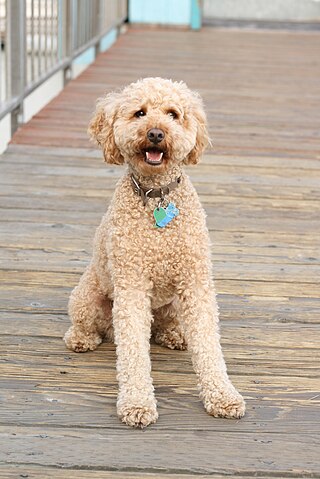
Dog crossbreeds, sometimes called designer dogs, are dogs which have been intentionally bred from two or more recognized dog breeds. They are not dogs with no purebred ancestors, but are not otherwise recognised as breeds in their own right, and do not necessarily breed true.
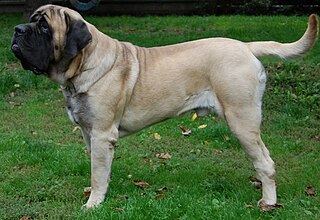
The English Mastiff, or simply the Mastiff, is a British dog breed of very large size. It is likely descended from the ancient Alaunt and Pugnaces Britanniae, with a significant input from the Alpine Mastiff in the 19th century. Distinguished by its enormous size, massive head, short coat in a limited range of colours, and always displaying a black mask, the Mastiff is noted for its gentle and loving nature. The lineage of modern dogs can be traced back to the early 19th century, but the modern type was stabilised in the 1880s and refined since. Following a period of sharp decline, the Mastiff has increased its worldwide popularity. Throughout its history the Mastiff has contributed to the development of a number of dog breeds, some generally known as mastiff-type dogs or, confusingly, just as "mastiffs". It is the largest living canine, outweighing the wolf by up to 50 kg (110 lbs) on average.

The Leonberger is a giant dog breed, whose name derives from the city of Leonberg in Baden-Württemberg, Germany.
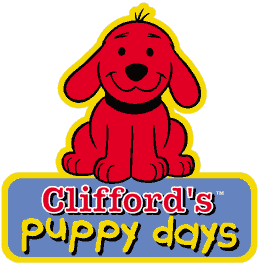
Clifford's Puppy Days is an animated children's television series that originally aired on PBS Kids from September 1, 2003 to February 25, 2006. The prequel to the 2000–2003 series Clifford the Big Red Dog, it features the adventures of Clifford during his puppy days before he became a big red dog and before moving to Birdwell Island.

The Lockhorns is a United States single-panel cartoon created September 9, 1968 by Bill Hoest and originally distributed by King Features Syndicate to 500 newspapers in 23 countries. The Lockhorns joined Andrews McMeel Syndication (AMS) January 1, 2024 and continues to appear in hundreds of newspapers worldwide and online through websites including AMS's GoComics! After Hoest's death in 1988 the comic panel was continued by his wife Bunny Hoest and cartoonist John Reiner. In 2017 Hoest donated the archives of more than 37,000 of her cartoons - including The Lockhorns, Howard Huge and others - to Adelphi University where she obtained a Bachelor of Arts degree and an honorary doctorate.
Bunny Hoest, sometimes labeled The Cartoon Lady, is the writer of several comic strips, including The Lockhorns, Laugh Parade, and Howard Huge, the first of which she inherited from her late husband Bill Hoest. She is the co-creator of Bumper Snickers in 1974, Agatha Crumm in 1977, Laugh Parade in 1980, Howard Huge in 1981, What A Guy! in 1986, and Hunny Bunny's Short Tales in 1992.

John Reiner is a cartoonist who collaborates with writer Bunny Hoest on three cartoon series: The Lockhorns, syndicated by King Features, and Laugh Parade and Howard Huge.

William Pierce Hoest was an American cartoonist best known as the creator of the gag panel series, The Lockhorns, distributed by King Features Syndicate to 500 newspapers in 23 countries, and Laugh Parade for Parade. He also created other syndicated strips and panels for King Features.

Clifford the Big Red Dog is a preschool animated educational children's television series, based upon Norman Bridwell's children's book series of the same name. Produced by Scholastic Productions, it was originally aired on PBS Kids from September 4, 2000, to February 25, 2003. A UK version originally aired on BBC Two in April 2002.
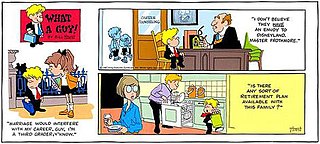
What a Guy! is an American comic strip created by Bill Hoest and Bunny Hoest, the team responsible for The Lockhorns and Agatha Crumm. It began in March 1987, just over a year before Hoest's death in 1988.

Pound Puppies is an animated children's television series developed by Wendy Klein Moss, Nancy Steingard, Paul Germain and Joe Ansolabehere for the Hub Network. It premiered on October 10, 2010 in the United States as the first Hub "original series". It also aired on YTV in Canada and on Boomerang in the UK, Ireland and Australia. Produced by Hasbro Studios, it was the second series to adapt Pound Puppies into a cartoon format. Originally a property by Tonka, Hasbro acquired Tonka itself and currently manages Pound Puppies. The plot style and music were similar to the 1960s TV series Hogan's Heroes and to films like Stalag 17 and The Great Escape. 9 Story Entertainment animated the first seven episodes of the series, followed by DHX Media/Vancouver from episode 8 onwards.

The Twisted Whiskers Show is an animated comedy television series based on the Twisted Whiskers greeting cards created by Terrill Bohlar for American Greetings. It began airing as the first program of the Hasbro/Discovery TV network, Discovery Family on October 10, 2010. 26 half-hour episodes of the CG series were produced by American Greetings Properties, DQ Entertainment, MoonScoop LLC, CloudCo, Inc., and Telegael. The series was also aired on Teletoon in Canada, CBBC in the United Kingdom, MTV3 Junior in Finland and Disney Channel in Japan.
Dookie or Rozavel Golden Eagle was a Pembroke Welsh Corgi bought in 1933 by King George VI and was the first of many Welsh Corgis to join the Royal Family. The dog was especially popular with Queen Elizabeth II, who from then on owned over thirty corgis in her lifetime.
Dog Daze is a 1937 Warner Bros. Merrie Melodies directed by Friz Freleng and animated by Robert McKimson. The short was released on September 18, 1937.















